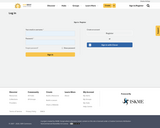
A way to take inventory of band instruments using QR Codes. This website describes the process.
- Subject:
- Arts Education
- Band
- Material Type:
- Reading
- Date Added:
- 12/01/2019

A way to take inventory of band instruments using QR Codes. This website describes the process.

Students find and calculate the angle that light is transmitted through a holographic diffraction grating using trigonometry. After finding this angle, student teams design and build their own spectrographs, researching and designing a ground- or space-based mission using their creation. At project end, teams present their findings to the class, as if they were making an engineering conference presentation. Student must have completed the associated Building a Fancy Spectrograph activity before attempting this activity.

Students learn to apply the principles and concepts associated with energy and the transfer of energy in an engineering context by designing and making musical instruments. They choose from a variety of provided supplies to make instruments capable of producing three different tones. After completing their designs, students explain the energy transfer mechanism in detail and describe how they could make their instruments better.

Explore music instruments, games and activities.

Students work with partners to create four different instruments to investigate the frequency of the sounds they make. Teams may choose to make a shoebox guitar, water-glass xylophone, straw panpipe or a soda bottle organ (or all four!). Conduct this activity in conjunction with Lesson 3 of the Sound and Light unit.

Music can loosely be defined as organized sound. The lesson objectives, understanding sound is a form of energy, understanding pitch, understanding sound traveling through a medium, and being able to separate music from sound, can provide a good knowledge base as to how sound, math, and music are related. Sound exists everywhere in the world; typically objects cause waves of pressure in the air which are perceived by people as sound. Among the sounds that exist in everyday life, a few of them produce a definite pitch. For example, blowing air over half full glass bottles, tapping a glass with a spoon, and tapping long steel rods against a hard surface all produce a definite pitch because a certain component of the object vibrates in a periodic fashion. The pitch produced by an object can be changed by the length or the volume of the portion that vibrates. For example, by gradually filling a bottle while blowing across the top, higher pitches can be generated. By organizing a few of these sounds with a clearer pitch, the sounds become closer to music. The very first musical instruments involved using various objects (e.g. bells) that have different pitches, which are played in sequence. The organization of the pitches is what transforms sounds into music. Since the first instruments, the ability to control pitch has greatly improved as illustrated by more modern instruments such as guitars, violins, pianos, and more. Music is comprised of organized sound, which is made of specific frequencies. This lesson will help define and elaborate on the connections between sound and music.

Play the guitar, piano, drums and flute online!
(Sorry, Parents!)

Lets kids play instruments online. Instruments include the guitar, piano, pan flute, drums, and bongos.